
MAY CONTAIN NUTS

Search Shorpy
SHORPY ART

Framed or unframed, desk size to sofa size, printed by us in Arizona and Alabama since 2007. Explore now.
Join and Share
Ad-Free Shorpy
Shorpy is funded by you. Patreon contributors get an ad-free experience.
Learn more.

Recent comments
- Recent view
- Hudson’s Big Store
- Say what??
- Grapes?!
- A Beautiful Moment
- Such joy
- Bethune-Cookman University today...
- Yellow sky at morning
- Side Winder
- Air Quality?
- Sojourner Truth riot
- None were so blind(ed)
- The less famous sister
- Good ol' days?
- Rise and Fall
- Goo Goo Ga Joob
- Ticket Retention
- Not the only one
- Vagaries of War
- Killed by Amtrak
- Back to the Future
- Wanted --
- If you can't stand the light
- Centralized Traffic Control, I believe
- What's really happening
- Heckuva remote control!
- Sometimes — Things Go Bump!
- I SEE THE LIGHT
- Union Switch and Signal Company
- Get That Light Out Of My Eyes
Member Photos
The Shorpy
Print Emporium
Print Emporium
Search Shorpy
Search results -- 30 results per page
- Young Gun: 1939
- ... for Hawaiian style playing, with the raised nut. Made in Chicago by the Harmony Co., distributed by the Bronson Co., to the best of my ... Posted by Dave - 01/13/2013 - 8:25pm -
![Young Gun: 1939 January 1939. "Sunflower Plantation. Son of tenant farmer in corner of living room. Pace, Mississippi." Note Sonny's suction-cup ammo. Large-format nitrate negative by Russell Lee for the Resettlement Administration. View full size.
Butcher PaperTterrace we always licked the suction cups before shooting the darts usually at the tv or a window. Glass and foreheads seemed to be the only things that they would stick to.
Suction cup?We don't need no stinking suction cup. The first thing my
brother and I would do is pull the cup off and sharpen the
end in a pencil sharpener. our main targets were cardboard
boxes. I'll leave it at that.
Cool guitar!Melody King, set up for Hawaiian style playing, with the raised nut. Made in Chicago by the Harmony Co., distributed by the Bronson Co., to the best of my understanding. I collect and restore old Harmony guitars.
Streamline!Can anybody identify the toy in the box? Is it a travel trailer, or maybe a bus? And I like the ships wheel motif around the sound hole in the guitar.
No refrigerator hereToo bad because that's the only thing those darts stuck to. My uncle pronounced me "the laziest kid I have ever seen in my whole life" because I had tied thread to my darts so I wouldn't have to get up and go retrieve them.
I had one.Those suction darts would never stick to anything.
[Surely I can't be the only one who spit on the cup and stuck it to my forehead. And got a nice round blue bruise for my trouble. - tterrace]
WallPAPERI just love that "Real McCoy" wall PAPER - likely with no insulation and Tar Paper on the outside. Pity the kid did not have crayons to draw on it.
PowerlessFrom what I can see, there's probably no electricity in the house. The huge "A" battery , and the "B" battery which may be behind it on the chair, probably powered a radio among other things. The AM receiver on the table looks like it was gutted but they may have had another one. It also appears that Our Gang's "Alfalfa" was a relative.
Farm radioThe antenna and ground leads for the radio are visible just to the right of the table; the antenna lead disappears through a hole in the window frame. It's likely the radio is a Silvertone, mail-ordered from Sears and Roebuck, just like the batteries powering it. Prior to the Electrification Act of 1936 these "farm sets" were popular in rural areas; since it took several years for the "high line" to reach many farms they were still offered in the mail order catalogs in 1940.
Streamlined CampingThe toy in the shoe box is a stamped steel toy camping trailer from the All Metal Products Co. in Wyandotte, Mi. It had nickel trim and real rubber wheels.
Hopefully the kid still had the really cool LaSalle sedan that pulled the camper!
Boys and their toysLike this young lad, I also had a suction cup gun that I used to shot at anything and everything. And like this lad probably did, I found out why there was a belt hanging on the wall within easy reach of mom and dad.
Poetry FansI like how the portrait of Emily Dickinson has pride of place for this family.
Farm RadioI believe OldeRadio is correct. The radio appears to be a 1937 Silvertone 4661, seen here: http://radioatticarchives.com/radio.htm?radio=3427 Probably a nice set at that time.
(The Gallery, Kids, Russell Lee)](https://www.shorpy.com/files/images/SHORPY_8b37111a.thumbnail.jpg)
- Toy Story: 1949
- ... Projector
Billboard, December 31, 1949.
CHICAGO, Dec. 24. — Ray Marchbanks, regional chief for Capitol disks ... Posted by Dave - 09/26/2013 - 12:24pm -
![Toy Story: 1949 October 1949. "Cowboy entertainer Gene Autry posing with children's clothing and toys which have his name and/or image on them." Kodachrome from photos by Frank Bauman and Stanley Kubrick for Look magazine. View full size.
RoyRoy Rogers is always mentioned as the TV and movie cowboy with a plethora of marketing items for sale, but this photo proves that Gene was certainly no slouch. Kind of miss this wholesome children's entertainment. Simple stories with real morals included!
Successful BrandingThe postwar prosperity + Baby Boom + TV seems to have been quite lucrative for him--and the "Repeating Cap Pistol" pictured recently brought an eBay seller $461 after spirited bidding.
Sixty-four years laterThis picture of old familiar boy's toys and joys really takes me back to my youth when my little brother and our neighbor were both completely in awe of Gene Autry and Roy Rogers (who seemed to be featured at every weekend matinee in our small town). The neighbor was even named Gene and took his idol very seriously, owning just about all of the items pictured plus an entire bedroom suite of Autry furniture, bedspread, sheet, etc. Today, both the real Genes are gone. We all played with toy guns and none of us became murderers or even animal hunters, just pretend cowboys who kept our loved ones and property safe from all those "bad guys".
Tried the cap guns ...but never wore the jeans.
The second luckiest man in show businessGod bless Gene "Ornery". No actor, and not much of a singer, but a darn good businessman for a kid from Oklahoma! Flying A gas stations, KTLA TV, the Angels, and the Autry Museum of Western Art in LA, and I'm sure there was much more.
(In my opinion, Ringo Starr still ranks #1 luckiest.)
ViewmasterThat looks like a Viewmaster viewer at the upper right, behind a series of Viewmaster disks in their cardboard sleeves.
[It's actually a "Hollywood Toy Television," which showed short film strips of still pictures. -tterrace]
The historical star of this photo is...Eastman Kodachrome -- with due respect to Gene Autry. Sharp, rich colors combined with perfect skin tone.
Trigger fingersI'm a big Gene Autry fan but I'm disappointed he had both fingers firmly on the triggers of those cap guns. That's no way to teach gun safety to impressionable youngsters.
A quick eBay peekComics- $10-$45
Chaps- $150
Holster (w/o gun) $55
T-shirt (on left) $24.99
Spurs (w/o leather strap) $50
Scarf/bandanna-$10.50
Fan badge-$5.00
Cap gun (w/o grips) $10.00
Cap gun (w/grips) $80-$175
Watch- $30 or $175
White double holster (in red box)- $195
I found 6200 separate listings!
A few highlights shown there but not in the image:
A record player, many records, flashlights, alarm clock(NIB), dime novels, pennant, guitar, lunch boxes, LA Angels Autry autographed baseball, pen knife, Flying A horseshoe nail ring, and far too many more to list.
Enough for a museum.
Red "TV" viewerit seems to be styled after the Bakelite General Electric TV from the same year.
TV collectors (ahem) refer to this model as "The Locomotive" because it resembles the streamlined locomotives of the time.
Moppet Picture Projector
Billboard, December 31, 1949.
CHICAGO, Dec. 24. — Ray Marchbanks, regional chief for Capitol disks here, and Henry Saperstein, prexy of Hollywood Toy Television Corporation, new moppet picture projector, met last week to discuss the possibility of Cap taking over national distribution for the kid gimmick. Introduced to the market last June, the toy video set retailed at $9.95 for a red plastic case outfit that carried a four-by-three inch screen. By inserting foot-long strips of film, the child could see a six-minute show of animated cartoons. The cost of the original set included six such strips, which make a complete 30-minute movie. Saperstein has 17 story subjects, including Woody Woodpecker, Hopalong Cassidy and Gene Autry. These strips retailed for six for $1.
More Picture for MORE DollarsAccording to my Inflation Calculator, that television would cost about $2,280 in 2012 dollars (the last year available).
All that for what, two or three channels - and NO UHF stations unless you bought a separate converter.
Hoppy, Gene and RoyThough I would watch Gene and Hoppy, Roy was the real deal, when I was a lad. I was Roy, my bike was Trigger. Our dog, a Cocker Spaniel had little interest in being Bullet. My cousin, who's real name is Dale would, of course, be Dale. I had RR cap pistols, but rarely had the nickle for a box of caps. No problem, "Pow Pow" sounds were almost as good. We must have killed a thousand bad guys.
Ironically, one of my current "heroes" is, also, named Roy Rogers, the finest slide guitarist around today. His given name is RR, unlike the, late, Leonard Slye.
BTW, if you visit Los Angeles, The Autry Museum is a must see
Media Mogul1949 was also the year he sold 2.5 million copies of "Rudolph the Red-Nosed Reindeer" and the year before he came out with "Here Comes Santa Claus." The man was clearly doing something right.
(Kodachromes, LOOK, Stanley Kubrick)](https://www.shorpy.com/files/images/SHORPY_01232u.thumbnail.jpg)
- A Second Helping: 1942
- June 1942. Meanwhile, back in Chicago, we return to the Kassalo family kitchen for a another helping of " ... HoneyWheat Bread. - Dave]
(The Gallery, Ann Rosener, Chicago, Kitchens etc., WW2) ... Posted by Dave - 10/03/2017 - 12:26pm -
![A Second Helping: 1942 June 1942. Meanwhile, back in Chicago, we return to the Kassalo family kitchen for a another helping of "American as the Smiths and Joneses." Photo by Ann Rosener for the Office of War Information. View full size.
I'd recognize that jaw anywhere!On the wall, between FDR and the calendar: Gen. Douglas MacArthur, then Supreme Commander, Southwest Pacific Theater.
The real Summer of '42I wonder if any of the chairs match up. Great little cast iron stove.
Bread of LifeIs that a cellophane-wrapped loaf of bread on the table? I thought most breads were wrapped in paper or waxed paper through the forties. But maybe I'm wrong!
["California-Style" HoneyWheat Bread. - Dave]
(The Gallery, Ann Rosener, Chicago, Kitchens etc., WW2)](https://www.shorpy.com/files/images/SHORPY-8b07380a.thumbnail.jpg)
- Super Trouper: 1952
- ... March 1952. "Marlene Dietrich makes her stage debut in Chicago." Color transparency by Phillip Harrington for Look magazine. View ... and the French Légion d’honneur.
(Kodachromes, Chicago, LOOK, Phillip Harrington, Portraits) ... Posted by Dave - 08/20/2017 - 5:18pm -
![Super Trouper: 1952 March 1952. "Marlene Dietrich makes her stage debut in Chicago." Color transparency by Phillip Harrington for Look magazine. View full size.
I vant to be aloneI would have loved to be alone with her.
[Um, that was Greta Garbo. - Dave] Ooops!! My mistake. I stand corrected. Thank you. Perhaps I should go stand outside the barracks, by the corner light and wait for Marlene.
State Lake Theatre One day only. March 6, 1952.
And proudly displayingthe American Medal of Freedom and the French Légion d’honneur.
(Kodachromes, Chicago, LOOK, Phillip Harrington, Portraits)](https://www.shorpy.com/files/images/SHORPY-08748u.thumbnail.jpg)
- In for Overhaul: 1942
- December 1942. "Chicago, Illinois. In the Chicago & North Western locomotive repair shops." Photo by Jack Delano, ... the inside was always a mystery to me.
(The Gallery, Chicago, Jack Delano, Railroads) ... Posted by Dave - 08/20/2014 - 10:17am -
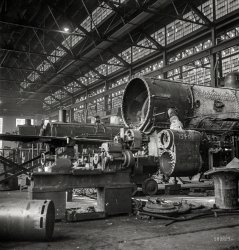
- Back Issue: 1920
- ... negative. View full size.
Stylish Is that the Chicago Manual of Style near the left end? I have a much more recent edition, ... Posted by Dave - 09/24/2014 - 6:02pm -
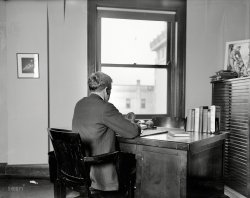
- Low Noon: 1952
- November 1, 1952. "Chicago framed by Gothic stonework high in the Tribune Tower. This view of Chicago's downtown shows the low-lying smog which blanketed the area one recent ... looked dingy before it was renovated.
(The Gallery, Chicago) ... Posted by Dave - 03/28/2015 - 7:57am -
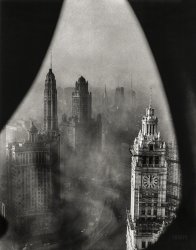
- Driven to Drink: 1930
- December 16, 1930. Chicago. " The Crusaders have new slogans. Miss Elizabeth Thompson was one of ... To Travel While the photo above did not appear in the Chicago Tribune, an article in the paper on Tuesday, December 16, 1930, Page 17 ... Phillips.
(The Gallery, Bizarre, Cars, Trucks, Buses, Chicago, News Photo Archive) ... Posted by Dave - 06/06/2019 - 2:31pm -
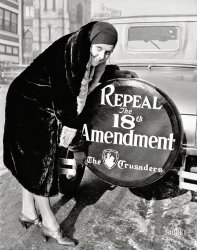
- Two of a Kind: 1941
- July 1941. Chicago. "Man seated on corner of Jefferson Street and Vernon Park Place." 35mm ...
Sleuthing Great detective work!
(The Gallery, Chicago, John Vachon) ... Posted by Dave - 09/22/2020 - 3:30pm -
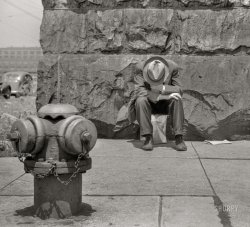
- Big Four: 1940
- ... New York Central's subsidiary, the Cleveland, Cincinnati, Chicago and St. Louis Railway, popularly called "The Big Four." The Big Four ... was, indeed, located next to the Cleveland, Cincinnati, Chicago and St Louis RR terminal at the intersection of Commercial Avenue and ... Posted by Dave - 05/25/2012 - 7:58am -
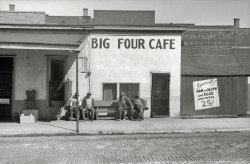
- War Machinists: 1942
- ... Midwest machine tool company. Republic Drill and Tool, Chicago." Photo by Ann Rosener, Office of War Information. View full size. ... (or twelve), another day.
(The Gallery, Ann Rosener, Chicago, Factories, WW2) ... Posted by Dave - 08/17/2017 - 11:13pm -
![War Machinists: 1942 August 1942. "Women in industry. Sharp eyes and agile fingers make these young women ideal machine operators. They're conditioning and reshaping milling cutters in a huge Midwest machine tool company. Republic Drill and Tool, Chicago." Photo by Ann Rosener, Office of War Information. View full size.
Hand SharpeningI'm sure these ladies are grinding "Back Relief" on the cutters as the geometry is not as important and much faster than a machine. I say this as there is no setup required for each cutter. In the old days (1970s), end-mills were still having their back relief geometry developed by hand grinding.
Agile fingersFrom the bandages on her fingers it looks like they weren't quite agile enough.
[Those look more like finger guards than bandages to me. -tterrace]
Touching-up a milling cutter freehand!Milling machine cutters must have all their teeth shaped identically if they are to make a smooth, chatter-free cut. This is usually done by mounting the cutter in a tool and cutter grinder, which has jigs and fixtures to hold various milling cutters for precise grinding of each tooth.
These women are touching-up cutters from a horizontal milling machine freehanded on an ordinary pedestal grinder! I would not have thought this was possible! It would require an incredibly steady hand and a very good eye to do this!
Grinding out nicksI bet they are grinding out nicks or dings on the teeth, the cutter will then be put on a sharpening machine. The cutter will cut smaller after resharpening, but it cuts just as well. During the war a lot of cutters were saved this way.
BurrsI think they might be just grinding off burrs left by a gear cutter. The lady is wearing what we called finger savers. It's dangerous to have that scarf like thing around her neck near a grinding wheel.
Re-PurposingIf the chips and carbon spots can be removed, the face can be re-sharpened in the same diameter as before, if not a new outside diameter (O.D.)can be achieved. Most WWII tooling was made to be reused if possible, then re-purposed when necessary. Face cutting on surfaces did not always need a certain O.D., the cuts only needed to overlap (while being straight and parallel)for a smooth face. Much of the WWII arsenal was made by utilizing tooling most engineers thought to be used only briefly. A few dozen (hundred) extra parts were, in effect, a bonus, since the running changes were minimal.
August, not so much...but I guess those lamps probably kept those fingers toasty warm in a war plant in the winter in Illinois. Factories had very little "climate control," especially year-round until the late 80s when some geniuses realized that micro-dimensions were affected by shop conditions when machined, and not just to keep employees comfortable. I do not miss a lot of my younger years in those places; the naivete of the young engineers I shall treasure - another story (or twelve), another day.
(The Gallery, Ann Rosener, Chicago, Factories, WW2)](https://www.shorpy.com/files/images/SHORPY-8e11162a.thumbnail.jpg)
- Knows the Drill: 1942
- ... points have improved. Republic Drill and Tool Company, Chicago." Photo by Ann Rosener for the Office of War Information. View full ... used ones, I'd guess.
(The Gallery, Ann Rosener, Chicago, Factories, WW2) ... Posted by Dave - 05/01/2015 - 9:55am -
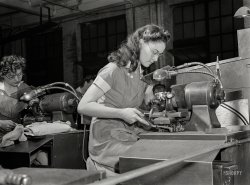
- Indiana Janes: 1908
- ... America" for nothing. It was a good halfway point between Chicago & Cincinnati, and lots of other places. So it's not surprising to ... Posted by Dave - 09/09/2011 - 12:12pm -
![Indiana Janes: 1908 August 1908. "Noon hour in an Indianapolis cotton mill. Witness, E.N. Clopper." View full size. Photograph and caption by Lewis Wickes Hine.
Satisfied?As another commenter mentioned, here's another Lewis Hine photo where the subjects are not glaring angrily at the photographer. Could it be that the workers were actually satisfied with their worksite? That doesn't fit in well with Hine's agenda that workers were abused by their employer. So, Hine could be balanced in the way he shows his subjects.
BTW, it looks like one could get pretty dirty working in a cotton mill (in Indianapolis, of all places!). Surprising, but what do I know.
Probably a FridayThey're Hoosiers. It's probably a Friday. Payday. Basketball game this evening. Life is good.
IndianapolisIndianapolis didn't get the nickname "Crossroads of America" for nothing. It was a good halfway point between Chicago & Cincinnati, and lots of other places. So it's not surprising to me that cotton would be shipped here for working.
Mill GirlsMy great-grandmother worked in a Virginia cotton mill as a teenager in the 1910s. In 1975 I interviewed her as part of my graduate thesis. One thing she kept repeating was what a "wonderful" job it was, and how "blessed" she was to be able to work there. When I asked about workplace conditions she said the only "workplace" the girls had before that was in the fields. "Crawling though [poop]." Maybe that's why they all look so happy.
Indiana Janes: 1908Hine didn't create those awful working conditions to fit his "agenda," he took the pictures to point out the awful working conditions. Perhaps these people are smiling because it's what's expected when someone points a camera at you, especially as this might be the only photograph that would be taken of you.
[ Conditions were not "awful." No one was making these girls work here. Lewis Hine took these pictures because that's what he was paid to do. His goal was ending child labor, not the employment of people these girls' age. - Dave]
South Carolina cotton millsI worked in 2 cotton mills in Greenville, SC in the 1970's. I worked pretty much every job in the Draper and Sulzer weave rooms. This was past the era when the mills built mill villages with houses, schools,baseball fields, and gyms for the employees but the people I worked with were happy, hard working people who liked their jobs. The biggest problem was the lack of a good retirement plan in the mills but then the employees were expected to plan and be prepared for their own retirement. I look back on my experience as a good one overall. The mill employees were like an extended family and took care of each other.
Who?I would love to know who these women and girls are. I have lived in Indianapolis my whole life, and have a lot of family history here.
(The Gallery, Factories, Indianapolis, Lewis Hine)](https://www.shorpy.com/files/images/01327u.thumbnail.jpg)
- Private Alley: 1942
- April 1942. Chicago. "Negro businessmen and women. On his way to play at an afternoon show, ... photos taken by Jack Delano in April 1942. Red died in Chicago in 1981, aged 69.
A Red Saunders Playlist
Week Day Blues ... (1951)
Hambone (1952)
(The Gallery, Chicago, Jack Delano) ... Posted by Dave - 09/12/2018 - 1:11pm -
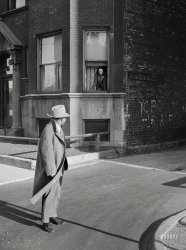
- Instant Message: 1942
- November 1942. "Chicago, Illinois. These pneumatic tubes in the Illinois Central Railroad ... and tie for the trip home.
(Technology, The Gallery, Chicago, Jack Delano, Railroads) ... Posted by Dave - 04/26/2013 - 11:47am -
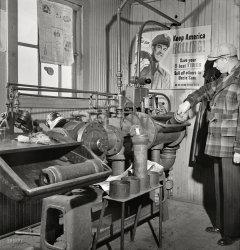
- Tree House: 1923
- ... exhibit for the 1893 World's Columbian Exposition in Chicago.
The tree was cut in the General Grant National Park – which is ... Posted by Dave - 12/11/2011 - 10:45am -
![Tree House: 1923 Washington, D.C., 1923. All it says here is "Dept. of Agriculture." Back when the place was run by the Keebler Elves. National Photo Company. View full size.
Noble Redwood Tree HouseMore photos here:
This was the General Noble Redwood Tree House – a 50-foot section of a 2,000 year-old giant sequoia tree. This idea was conceived as an impressive government exhibit for the 1893 World's Columbian Exposition in Chicago.
The tree was cut in the General Grant National Park – which is now Kings Canyon National Park in California. A team of twenty cutters worked for seven days, fifty feet above the ground, to cut the 26-foot diameter tree.
Workers then hollowed out the stump, and cut the tree into some 2-3 dozen sections, which would be reassembled on the site of the exposition – complete with an interior circular staircase!
In 1894 the tree was moved again to the grounds of the Agriculture Building, on the Mall in Washington, DC. It was then that the structure was made waterproof with the addition of a peaked roof and four dormer windows, and covered with redwood shingles.
The tree house remained on the mall until 1932, when it was placed in storage at the Agriculture's Experimental Farm in Arlington, Virginia. In 1940 the Farm was transferred to the Army for part of the Pentagon grounds, and the tree was likely burned at that time.
Early LOTR StyleI think that's where Gandalf used to live. He eventually had to move out because of all the carpenter ants (his "Jedi tricks" had no deterrent effect upon them). Nowadays he's in a Tampa condo.
Jefferson Drive at 12th StreetTo the right is the Department of Agriculture to the left is the Freer Gallery. Between them is 12th Street SW, a service road and tunnel under the Mall. I crossed the Mall, 100 feet from there yesterday morning. The tree house is gone but the two buildings are still there.
Tree FarkFarked again!
Original TIFF?I've searched high and low for the higher-res source file of this image on the library of congress site and elsewhere and I can't find it for the life of me. Could anyone point me in the right direction?
[It's here.]
(The Gallery, Curiosities, D.C., Farked, Natl Photo)](https://www.shorpy.com/files/images/SHORPY_30519u1.thumbnail.jpg)
- Proviso South: 1942
- South Yards at the Chicago & North Western Proviso Yards. December 1942. View full size. ... in the east, Boston + NYC.
(The Gallery, Kodachromes, Chicago, Jack Delano, Railroads) ... Posted by Dave - 08/30/2012 - 12:01pm -
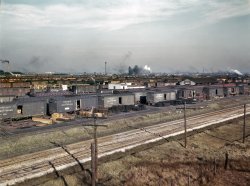
- Night Moves: 1941
- ... April 1941. "Auto convoy trucks at service station near Chicago." Medium format negative by Russell Lee for the Farm Security ... even heavy bombers.
(The Gallery, Cars, Trucks, Buses, Chicago, Gas Stations, Russell Lee) ... Posted by Dave - 12/04/2018 - 5:19pm -
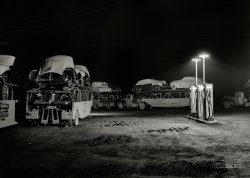
- Philly P.O.: 1900
- ... fight Annenberg's goons, who were veterans of the violent Chicago Newspaper Circulation wars. In the event, the Roosevelt people indicted ... Posted by Dave - 03/21/2020 - 5:32pm -
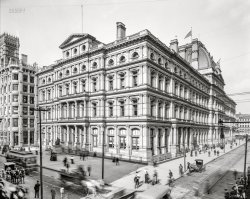
- Feminine Propensities: 1942
- ... drills, these women employed by Republic Drill & Tool, Chicago, roll the drills down a slight incline to determine regularity of ... weekend warrior/laymen.
(The Gallery, Ann Rosener, Chicago, Factories, WW2) ... Posted by Dave - 12/13/2013 - 12:38pm -
![Feminine Propensities: 1942 August 1942. "Testing small diameter, high-speed twist drills, these women employed by Republic Drill & Tool, Chicago, roll the drills down a slight incline to determine regularity of diameter. It's a job requiring patience and finger dexterity, and these young women possess those definite feminine propensities for just such work." Photo by Ann Rosener, Office of War Information. View full size.
Magnifiers?Every woman is wearing glasses. I would assume that these are magnifiers of some kind to help her make quality control judgements.
[Safety glasses, to protect their eyes. - Dave]
Twist drills?A term used by machinists! Nice. DRILL BIT to the regular weekend warrior/laymen.
(The Gallery, Ann Rosener, Chicago, Factories, WW2)](https://www.shorpy.com/files/images/SHORPY_8b07334u.thumbnail.jpg)
- Melrose Park: 1942
- Chicago & North Western classification yard, December 1942. The trestle ... by Jack Delano.
(The Gallery, Kodachromes, Chicago, Jack Delano, Railroads) ... Posted by Dave - 08/04/2012 - 11:03pm -
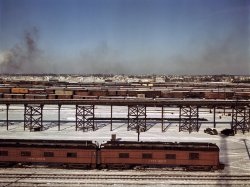
- New York Life: 1900
- September 11, 1900. "New York Life building, Chicago." The building, at LaSalle and Monroe streets, was completed in 1894, ... to do it to preservation standards.
(The Gallery, Chicago, DPC) ... Posted by Dave - 07/02/2017 - 2:28pm -
![New York Life: 1900 September 11, 1900. "New York Life building, Chicago." The building, at LaSalle and Monroe streets, was completed in 1894, with major additions in 1898 and 1903. 8x10 inch glass negative, Detroit Publishing Company. View full size.
Lasalle and Monroe: 2017Like many other Loop properties, this has been converted to a boutique hotel. The Kimpton Grey Hotel opened in 2016.
Look Out for the CurveThat continuous line of hatch covers between the inner rail and the slot as the streetcar track goes around the corner means that this was a "pull curve", the cable car had to hold on to the rope all the way around, and would do so until 1906.
Lost CraftsmanshipI'm amazed daily by the amount of masonry craftsmanship used on the upper floors of early buildings like this. Decoration and ornamentation in places or so high they'll never be fully appreciated by those at ground level.
Headless horse?There appears to be a headless horse in front of the building.
I hope this is not really the case.
Cornice-ectomyIt would be a nice, classy gesture if they replaced the original, prominent cornice. I am not, however, holding my breath.
[One way they're dealing with cornices in Detroit. -tterrace]
"Cornice Danger" prompted removalsNumerous buildings lost pieces or whole sections of their uppermost cornices as age and freeze-thaw took their toll on the materials through the 1920s and 30s.
In 1938 the City gave itself the authority to require owners to remove cornices deemed dangerous. This threat was enough that by the 1950s wholesale decapitation of these elements was underway.
However, given the successful restorations of several cornices in recent years (like the Marquette building just around the corner on Dearborn) it is surprising that the just performed hotel conversion did not add this historic element back. Probably it was just deemed too expensive, or, if historic tax credits were involved, there wasn't clear enough documentation of the original to cornice to do it to preservation standards.
(The Gallery, Chicago, DPC)](https://www.shorpy.com/files/images/SHORPY-4a08129a.thumbnail.jpg)
- Deluxe Wash: 1942
- November 1942. "Chicago, Illinois. Washing a locomotive at the coaling station at an Illinois ... Paducah Shops between 1937 and 1943.
(The Gallery, Chicago, Jack Delano, Railroads) ... Posted by Dave - 05/08/2015 - 1:33pm -
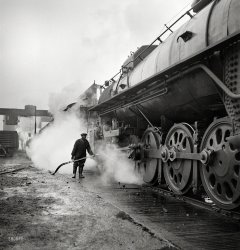
- Bob & Paul: 1910
- ... According to a 1912 directory, ticket offices of the Chicago, Milwaukee & St. Paul R.R., the Chicago & Great Western R.R., the Chicago and Northwestern R.R., the ... Posted by Dave - 08/23/2017 - 9:46am -
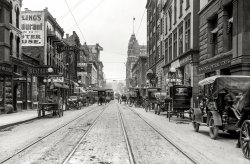
- Yesterday's Headlines: 1941
- ... Blast from the Past When I was a high school senior in Chicago I took a print shop class, where we were taught to operate a Linotype ... Posted by Dave - 12/12/2018 - 9:30am -
![Yesterday's Headlines: 1941 June 1941. "Mr. Cary Williams, editor of the Greensboro Herald Journal, a newspaper in Greensboro, Georgia." Spitting hot lead at an ancient Linotype machine. Note the custom-fitted ergonomic back support and whittled-down chair. Medium format negative by Jack Delano. View full size.
Amazing technologyIn the late 1970s I was studying graphic design, and our instructor took a group of us to the offices of Sunset Magazine to see a linotype in action. The publication was just weeks away from going computerized, but the operator put on quite a show for us. There's nothing like moving parts to make work seem entertaining.
etaoin shrdluI still have-and use regularly-a Linotype machine. Also, the metal is melted and used at around 535 to 545 degrees. Less than that it won't melt properly, and much above that is when you are apt to get squirts.
The aroma is uniqueI worked in the office of a hot lead Hearst paper in Baltimore in the '70s. The building’s back stairs included a landing that was open to the pressroom, and the odor of molten lead poured into stairwell. Nothing else smells quite like that. Shorpy brought it all back to me!
Printer's DevilThis reminds me of one of my favorite Twilight Zone episodes starring Burgess Meredith as the devil masquerading as a reporter who promises to salvage a failing newspaper in exchange for the editor's soul.
LineageI believe Etaoin Shrdlu was Lorem Ipsum's grandpa.
ETAOIN SHRDLUA well-known "phrase", but I followed Dave's LMGTFY link, and was surprised not to find the reference that first came to mind -- "Etaoin Shrdlu" is the title of a 1942 short story by Fredric Brown about a sentient Linotype machine.
Etaoin shrdluIt had to be said.
Huh?Over my head this morning.
[Google it. - Dave]
ProgressEarlier this week, I ran across a story of an 8 monitor, 18 million pixel custom workstation with a sling chair that is like a modern incarnation of Mr. Williams' rig.
Hot LeadvilleIn Saguache, Colorado, there's a newspaper called the Saguache Crescent that is still produced daily on an old linotype machine.
Ah, yesterdayIn the 1960s when the Comanche (Texas) Chief was still a hot-type operation, I used to hang out in their print shop, watching Bob Carpenter set type (he was good enough as a reporter AND printman that he would sometimes compose his articles directly on the lino) and Minor Taber and Woody Ormsby run the jobbing presses.
If I hit at the right time on Thursday afternoon, I could watch the crew wind up the big rotary press to run the week's edition of the Chief; that was a special treat.
A Blast from the PastWhen I was a high school senior in Chicago I took a print shop class, where we were taught to operate a Linotype machine just like this one. It always scared the hell out of me; we were warned that if we mistakenly left an open space in one of the lines of brass keys we were assembling, molten lead at 700 degrees Fahrenheit would "squirt" in our faces. Our machines were old and cranky, and I could rarely type out more than three lines before something would jam. Now I see them on display as museum pieces ... yikes!
Spitting LinotypeI have a documentary on the Linotype. (www.linotypefilm.com) Apparently, experienced operators could hear a warning sound to back off quickly to avoid getting hit by a bit of hot lead. I got a chance in the 1960s to see a room full of them at the News Call Bulletin in San Francisco. You don't forget a mechanical wonder like that.
Family TraditionCarey Jones Williams, April 6, 1901 - July 9, 1991
Carey (with an "e") later served on the University of Georgia Board of Regents. His son Carey Jr. is the current editor (and owner) of the Greensboro Herald Journal.
Not dead yetThere's a movie: http://www.linotypefilm.com and the Linotype is so loved that there are at least two organizations in my immediate area (Waltham and Haverhill, Mass.) with one or two working units:
https://www.charlesrivermuseum.org/
https://museumofprinting.org/collection/
I love old, well built, intricate and obsolete machinery. And Real Computers have switches and blinking lights.
LinosaursBoth The Printing Museum in Houston and the Baltimore Museum of Industry have full print shops on display, and if you hit 'em on the right days a retired operator (from The Houston Chronicle or Baltimore Sun) will be there to make them sit up and talk for you.
(Technology, The Gallery, Jack Delano, The Office)](https://www.shorpy.com/files/images/SHORPY-8c05858a.thumbnail.jpg)
- Columbian Caravels: 1905
- ... and La Rabida (Sanitarium for Children), Jackson Park, Chicago. Replicas of the Nina, Pinta and Santa Maria that participated ... a while.
(The Gallery, Bicycles, Boats & Bridges, Chicago, DPC) ... Posted by Dave - 10/13/2014 - 10:27am -
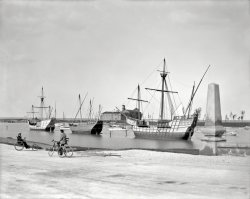
- Five O'Clock Shadows: 1941
- July 1941. "Five o'clock crowds, Chicago." Noir in the afternoon. 35mm nitrate negative by John Vachon for the ... photo and the print are both beautiful.
(The Gallery, Chicago, John Vachon) ... Posted by Dave - 05/27/2015 - 9:52am -
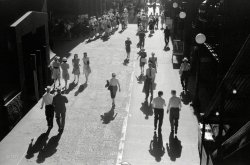
- Cotton on the Levee: 1903
- ... train traveled from New Orleans all the way north to Chicago. This is the route all blues artists and African Americans took to ... Posted by Dave - 08/09/2012 - 2:43pm -
![Cotton on the Levee: 1903 New Orleans circa 1903. "Mule teams and the levee." 8x10 inch dry plate glass negative, Detroit Publishing Company. View full size.
Behemoth ShipSecond time this ship has shown up on Shorpy and I still can't place her. She is a massive ship for her time, and much different from the Great Lakes freighters we see here frequently.
[It's the SS Proteus. - Dave]
CapturedA "Porgy and Bess" moment; you get the feeling that any moment great music will erupt. Or not.
Jax BreweryThat looks like the Jax (Jackson) Brewery behind the IC freight car. If so, we are facing upriver. The Jax brewery was converted to shops and restaurants many years ago. It's situated on Decatur street across from Jackson square (Plaza de Armes in Spanish times).
A Short 38 YearsThe Civil war had ended only 38 years before. Some of the people in this picture were probably born into slavery.
FlotsamI'd love to know the story about the stuff floating in the water at the left edge.
SS ProteusThinking of that ship got me poking around to read of it's sinking; found here
http://www.divehatteras.com/proteus.html
The train that traveled northThe Illinois Central train traveled from New Orleans all the way north to Chicago. This is the route all blues artists and African Americans took to leave the south in droves to better lives up north,where there were jobs in countless factories,and better pay than picking cotton.
Jackson BreweryYes, that is indeed the Jackson Brewery, and we are looking uptown toward Canal St. As someone commented on the other picture like this, you can also see St. Patrick's Church steeple off in the distance to the right.
(The Gallery, DPC, Horses, New Orleans, Railroads)](https://www.shorpy.com/files/images/SHORPY_4a17029a.thumbnail.jpg)
- Stuck Truck: 1921
- ... It was manufactured by the Walker Vehicle Company of Chicago.
Heavy What character vehicles had in that time, I'd imagine ... Posted by Dave - 08/07/2012 - 9:38pm -
![Stuck Truck: 1921 Washington, D.C., 1921. View full size. National Photo Company Collection.
ElectricThe poster has a point. There was a Walker electric truck in 1918. Here we are almost a hundred years later and we're working on creating electric trucks again.
Truck featuresHow about those solid rubber tires? What do you think the large footlocker shaped box is between the front and rear wheels? Could it be a battery for an electric motor? I don't see any radiator for a gas engine. Check out the aahh-ooo-gah horn by the front seat.
Walker ElectricThat is indeed an electric vehicle. It was manufactured by the Walker Vehicle Company of Chicago.
HeavyWhat character vehicles had in that time, I'd imagine the front axle alone has enough metal to make a car today.
Police Call BoxCheck out the fire/police call box on the pole. I have one dating back to the 1800s.
Traffic ReportI am loving this series of vehicular disasters in DC! It beats the accidents I see during my daily commute.
Stuck TruckThe "house" window for windshield is very interesting!
Riding the Rails?Does it strike anyone else that it looks as though the wheels on this truck were designed to allow it to operate on railroad tracks? The front wheels have a railroad-style flange and the groove in the rear wheels looks it was make to ride on rails as well.
[This is a common early truck tire. Solid rubber and tubeless. - Dave]
A Really Federal ExpressAmerican Railway Express existed from 1917 to 1929, formed by the nationaization of the express mail services owned by Adams Express, American Express, and Wells Fargo Express. World War I was hard on the fractious US railway system. The successor private company to ARE was Railway Express Agency (REA), owned by the railroad companies. It lasted from 1929 til 1975: a victim of mismanagement, corruption, and more nimble competiton.
(The Gallery, Cars, Trucks, Buses, D.C., Natl Photo)](https://www.shorpy.com/files/images/03571u.thumbnail.jpg)
- Those Were the Days: 1939
- ...
White tires extra The Vogue Tyre & Rubber Co. of Chicago introduced the white tire 25 years earlier. Ford first offered a white ... Posted by Dave - 03/13/2015 - 10:17pm -
![Those Were the Days: 1939 San Francisco, 1939. "General Motors exhibit, Golden Gate International Exposition. Girl sitting on LaSalle auto." The five-passenger touring sedan only $1581, "delivered here." 8x10 inch Agfa acetate negative. View full size.
Selfie AlertCheck the bumper!
GeeOur old LaSalle ran great!
White tires extraThe Vogue Tyre & Rubber Co. of Chicago introduced the white tire 25 years earlier. Ford first offered a white tire option in April, 1934, for $11.25, not sure what that would be in today's economy. As a child, it was my job to clean the whitewalls with cleanser and a brillo pad, but rinse them quickly or else you're left with blue & whitewall tires, grandpa wouldn't have that!
No thermostat now@ Doubleclutchin - I have worked on new vehicles that do not use a thermostat. The water pump is driven by an electric motor, and is only used when necessary. An engine driven water pump steals horsepower, and doesn't need to flow as much at idle compared to higher RPM. The electric water pump can be turned off and on, and the speed varied according to demands the PCM calculates.
It's the penultimate!The LaSalle introduced a new era of automotive styling (1927) and the legendary designer, Harley Earl. 1940 was its last year of production.
My Parents' First CarMy parents had one of those as their first car after they married. Somewhere I have a photo of them with it. Mom was often mistaken for Rita Hayworth when they lived in California and looked a lot better on the fender than this woman, even in blue jeans.
Dad later gave the LaSalle to his brother who had ten kids. His brother still had it when I came along. But then, they still had everything they'd ever owned. My aunt was not a housekeeper so whenever she and the kids filled up the big old two-story, my uncle would just build her another just like it nextdoor. Cars accummulated the same way around their three houses and the old LaSalle was two abandoned houses over.
The last time I saw the LaSalle it was still in one piece, but every horizontal surface had been caved in by ten unruly kids jumping up and down on it. By then, my uncle had moved on to collecting Edsels.
I wouldn't be surprised if that LaSalle is still where I last saw it 50 years ago.
2015 LaSalle$1,581 would be $27,000 in today's dollars.
Whitewall tiresThose whitewall tires would be a real chore to keep clean. Some tires were white on both sides, supposedly to keep them cooler. Could this event be taking place in the "Cow Palace"?
[As the caption says, this was at the Golden Gate International Exposition, aka World's Fair, on Treasure Island. -tterrace]
Whitewalls on the inside?Were those tires white on both sidewalls?
[Double-sided whitewalls were fairly common until the very early 1940s. -tterrace]
No Market NicheSave for the Pontiac, LaSalle was the longest lived of GM's "companion" marques. Often quite stylish and always a bargain, LaSalle lay at an uncomfortable point on the price spectrum, overlapping the most expensive models of Buick and Oldsmobile on the low end and the cheaper series of Cadillacs on the upper.
In the end, it was perceived as stealing sales from GM's other marques and axed accordingly.
But yes, with its Cadillac flat-head V-8, it ran great indeed!
Soft SuspensionThe sagging of the front left of the vehicle alerts us to the softness of the suspension of these big, floating barges.
Shutter what?If you look closely, behind the grille of this La Salle you can see the "shutterstats" -- vertical vanes in front of the radiator that opened and closed thermostatically to control air flow. Although slower in operation, it was arguably a better sytem for controlling underhood temperatures than the current practice of thermostically regulating coolant flow.
Double sidedAbout those tires: was the practice designed to encourage reversing the tires periodically to even out wear or was it simpler to put the white walls on both sides?
(The Gallery, Cars, Trucks, Buses, San Francisco, W. Stanley)](https://www.shorpy.com/files/images/SHORPY-281-04.thumbnail.jpg)























